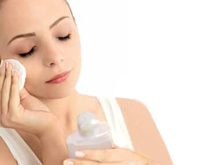Health Topics
-
Healthy Living
-
|
|
January 2011
|
New Year, Old Skin
6 Tips to Manage Ageing Skin and Hair |
| Dr Anshul Warman |
| |
 |
Growing old is mandatory; growing up is optional. But growing old has its own problems, indeed. As we think of ageing, the first thing that comes to our minds is the grey-white hair and wrinkled skin. But in today’s world of cosmetology, you can surely be surprised with what age has in store for you! |
10 Signs of Ageing
There are two distinct types of ageing. Aging caused by the genes we inherit is called intrinsic (internal) ageing or the normal ageing process. The signs include:
- Thin and transparent skin.
- Loss of underlying fat, hollowed cheeks and eye sockets.
- Loss of firmness on the hands and neck.
- Bones shrink away from the skin due to bone loss, which causes sagging skin.
- Dry skin that may itch.
- Decrease in sweat secretion and normal oil production of the skin.
- Greying hair that eventually turns white.
- Hair loss.
- Unwanted hair.
- Nail plate thins, the half moons disappear, and ridges develop.
The other type of aging is known as extrinsic (external) aging and is caused by environmental factors, such as exposure to the sun, smoking, repetitive facial expressions, gravity, sleeping positions. A number of extrinsic, or external, factors often act together with the normal aging process to prematurely age our skin.
Are You Getting Old?
Dull and Aging Skin: Freckles, age spots, spider veins on the face, rough and leathery skin, loose inelastic skin, a blotchy and mottled complexion, actinic keratoses (thick wart-like, rough, reddish-brown patches of skin), and skin cancer can all be traced to sun exposure. A gradual change in the skin tone from pink (in youthful skin) to subtle yellowish tinge in mature skin is due to lack of elasticity, chronic, accumulated photo-damage and inability of the aging skin to repair itself.
Wrinkles:Your skin at 60 can show any or all of these types of wrinkles: fine wrinkles that disappear when stretched, prominent expression lines, and well defined deep folds. As the skin’s elasticity declines, the effects of gravity become more prominent. Gravity causes the tip of the nose to droop, the ears to elongate, the eyelids to fall, jowls (fullness and looseness of the flesh of the lower cheek and jaw) form, and the upper lip disappear while the lower lip becomes more pronounced.
Dryness and Itching:With a decrease in the skin’s normal oil production, the protective barrier of the skin is lost. This leads to dry, dull looking, itchy and irritable skin, especially on exposed areas of the body. Sometimes spontaneously or due to excessive scratching, reddish patches of blood collection under the skin called purpura or ecchymoses can develop.
Hair loss:Common hair problems include overall thinning of hair, decreased density, dryness, lack of lustre and brittleness. This is due to associated diseases like diabetes, hypertension, drugs, and slow metabolism in old age and hormonal changes in females
Baldness:In females,widening of the hair partition is the first sign of baldness. In males, the classical male pattern baldness with frontal recession of hair can progress to total baldness, based on genetic predisposition and other factors like smoking, hair care, lifestyle, etc.
How Doctors Can Help
If you are bothered by visible signs of aging, a number of treatments are available.
- Injectable fillers and Botulinum toxin are suitable for people with busy lifestyles who do not want the inconvenience of a long recovery.
- Non ablative radiofrequency is a procedure that offers an alternative to the traditional surgical facelift.
- Dermabrasion, microdermabrasion, laser resurfacing, chemical peeling, and some topical treatments can restore skin, giving it a smoother and refreshed appearance.
Scientific research in the field of anti-aging continues to give rise to new and promising treatment options. A dermatologist can help you sort through the numerous options, including the myriad over-the-counter products. During a consultation, the dermatologist will examine your skin, discuss your expectations, and recommend suitable treatment options.
Help Yourself
General skin and hair care at the age of 60 must include:
- Regular mild cleansing.
- Limited use of soap to two or three times per week.
- Generous hydration and moisturising throughout the year with good creams (emollients). If you suffer from associated illnesses like diabetes, your dermatologist can suggest some emollients as per your skin’s requirements.
- Regular oiling of the scalp.
- Mild shampoo and hair conditioners.
- Avoid frequent use of hair colours (once in three months would be ideal).
|
 |
Dr. Anshul Warman is Consultant Dermatologist & Cosmetologist at Apollo Hospitals, Ahmedabad |
|
|